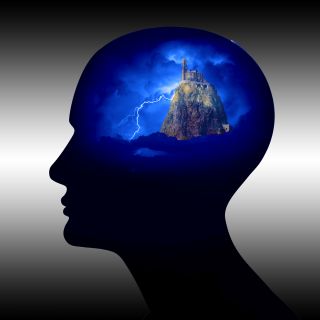Dopamine
Negotiating Your True Worth
Social needs and the old brain in the new world.
Posted July 16, 2015
Like other addicts, compulsive eaters have relationship issues. This is problematic because humans are a social species. In addition, unhealthy relationships promote addictive behavior.[1] Regrettably, in our #complicated world, having healthy relationships is complex. Reconciling self-worth with societal worth is among the chief enterprises in the basic economy of human relationships.[2, 3] For the ancients, it was simple: Establish your place in the social hierarchy, get the best mate, survive predators, starvation, and other prehistoric grief long enough to mate, then punch out at 25. Those were the good old days, when threats were real.

Today, the worst threats are consensual realities that are only real only because we agree they are real, such as beauty, social class, or education, occupation, age, and location grading.[4-8] For example, society presumes it is more desirable to be a young “power couple” with advanced degrees living in L.A. or New York than an old, single waiter with no degree living in a “fly-over state.”
However, many power couples really belong on a travel brochure for hell. Likewise, there’s someone slinging hash right now in a fly-over state who’s making this world a better place. Yet, we are consistently told to believe that our ages, jobs, education, and where we live largely define our worth.[9, 10] The reality is our dysfunctional society falsely assigns personal value to things that do not determine personal worth. How we do our jobs is more important than what we do, or the educational requirements to do it, our age, and where we live. Although a capitalist system values people with greater earning power, it does not mean they are actually more valuable than other people. Historically, societies have gotten the wrong memo, from Nazi Germany or the American Indian Genocide, to meagerly talented rappers making millions on vulgar, trite, misogynistic music.

More importantly, a serious problem arises when we mistake what we are (such as occupation, education, age, physical appearance, financial assets) and how much society values those things for who we are.[11-18] Our behavior determines who we are, not our credentials, social approval, or stations in life. Are we kind, decent, honest, humble, and caring? Do we have the courage to tell the truth even though it is scary? Do we have a solid work ethic?
Why is this important, and what does it have to do with addiction and relationships? When our relationships (with others, or society as a whole) are lacking, our brains perceive this as a threat that vital social needs are not being met, which affects our brain chemistry and promotes addictive behaviors.[19-22] Allow me to explain.
The ventral tegmental area (VTA) of the brain measures whether our crucial social needs are being met, by interpreting signals from the body and other parts of the brain.[23-26] Subcortical structures, such as the VTA, do not think—because evolution designed them to survive now and ask questions later, to promote survival.[27] If our simian ancestor heard a rustle in the bush, it might be tumbleweed. However, it could also be a lion. If he or she runs and it was tumbleweed, oh well, they still survive. If it was a lion, they also survive. However, if they stopped to think about it and it is tumbleweed, no problem. If it is a lion, it is a big problem. Hence, subcortical structures do not distinguish between perceived threat and actual threat.
The reason the VTA closely monitors our perception of social worth is because in social species, separation from the group means death.[28-32] Also, the VTA is in the reward system, where the basic currency is dopamine (the brain’s happy-dance drug). When social needs are met, dopamine is released.[24, 33-35] The problem is that the old mammal brain thinks we are still hiding from jackals and foraging for berries, so it misinterprets the signals of perceived social marginalization, social anxiety, discrimination, etc., as life threatening. Even though today a human couldn’t get separated from the group if they won the lottery.

The brain is a dopamine whore, and will get dopamine any way it can. Food and other addictions are goal-directed behaviors that the thinking part of the brain uses as alternate sources to generate dopamine to compensate for the decreases in dopamine release when we perceive problems with social worth.[36-40] When this persists, a goal-directed behavior such as consorting with our drugs of choice becomes a stimulus-response behavior because it encodes in a different part of the VTA.[41-45] This neurobiology is the same reason we automatically flip the light switch when we walk into a dark room even though we know the bulb is out. The goal of flipping the switch to get light is replaced by the stimulus-response: enter a dark room—flip the light switch.[43, 46-48]
Hence, we must distinguish between who we are and how much society values us because of what we are. If we make this distinction, it will affect the perception of threat, and subsequent prioritizing of social cues, from youth and Teutonic-beauty-standard-based media, salary gradients, etc., that tell us we are “less than.” This in turn will affect the signals to the VTA, which will decrease the need to consort with our drugs of choice to increase dopamine.[49-55]

More importantly, striving to be exceptional rather than deemed exceptional binds us to legislation by the congresses of each moment. This is where our destinies and legacies are articulated because the past and the future are valid only when they are the present. Understanding the true measures of worth is like building a fortress to shelter the old brain from the storms of a world that has grown too complicated and hostile. Knowing each moment brings the opportunity to be extraordinary, even if we were wretched the moment before, is like building that fortress on a rock. Remain fabulous and phenomenal!
Receive email notices of new posts:
Or visit me at:
UCLA Center for the Neurobiology of Stress at the David Geffen School of Medicine
References
1. Acier, D., L. Nadeau, and M. Landry, [Influence of the social network on consumption in drug addicts exhibiting psychiatric comorbidity]. Encephale, 2011. 37(4): p. 249-56.
2. McAleavey, K., Ten years of treating eating disorders: what have we learned? A personal perspective on the application of 12-step and wellness programs. Adv Mind Body Med, 2008. 23(2): p. 18-26.
3. Richter, D., B. Eikelmann, and T. Reker, [Work, income, intimate relationships: social exclusion of the mentally ill]. Gesundheitswesen, 2006. 68(11): p. 704-7.
4. Ross, M.W., Typing, doing, and being: sexuality and the internet. J Sex Res, 2005. 42(4): p. 342-52.
5. Battjes, R.J., Symbolic interaction theory: a perspective on drug abuse and its treatment. Int J Addict, 1984. 19(6): p. 675-88.
6. Berkowitz, D., L. Belgrave, and R.A. Halberstein, The interaction of drag queens and gay men in public and private spaces. J Homosex, 2007. 52(3-4): p. 11-32.
7. Bohannon, J.R. and P.W. Blanton, Gender role attitudes of American mothers and daughters over time. J Soc Psychol, 1999. 139(2): p. 173-9.
8. Cox, H. and A. Bhak, Symbolic interaction and retirement adjustment: an empirical assessment. Int J Aging Hum Dev, 1978. 9(3): p. 279-86.
9. Heatherton, T.F., Neuroscience of self and self-regulation. Annu Rev Psychol, 2011. 62: p. 363-90.
10. Sobal, J., K.L. Hanson, and E.A. Frongillo, Gender, ethnicity, marital status, and body weight in the United States. Obesity (Silver Spring), 2009. 17(12): p. 2223-31.
11. Alpass, F.M. and S. Neville, Loneliness, health and depression in older males. Aging Ment Health, 2003. 7(3): p. 212-6.
12. Arrindell, W.A., et al., Masculine Gender Role Stress: a potential predictor of phobic and obsessive-compulsive behaviour. J Behav Ther Exp Psychiatry, 2003. 34(3-4): p. 251-67.
13. Broussard, B.B., Women's experiences of bulimia nervosa. J Adv Nurs, 2005. 49(1): p. 43-50.
14. Brugger, P., B. Lenggenhager, and M.J. Giummarra, Xenomelia: a social neuroscience view of altered bodily self-consciousness. Front Psychol, 2013. 4: p. 204.
15. Chen, J.L. and C. Kennedy, Factors associated with obesity in Chinese-American children. Pediatr Nurs, 2005. 31(2): p. 110-5.
16. Crooks, D.L., The importance of symbolic interaction in grounded theory research on women's health. Health Care Women Int, 2001. 22(1-2): p. 11-27.
17. D'Augelli, A.R., et al., Aspects of mental health among older lesbian, gay, and bisexual adults. Aging Ment Health, 2001. 5(2): p. 149-58.
18. DeGrazia, D., Identity, killing, and the boundaries of our existence. Philos Public Aff, 2003. 31(4): p. 413-42.
19. Kreek, M.J., Opioid receptors: some perspectives from early studies of their role in normal physiology, stress responsivity, and in specific addictive diseases. Neurochem Res, 1996. 21(11): p. 1469-88.
20. Patel, K.T., et al., Robust changes in reward circuitry during reward loss in current and former cocaine users during performance of a monetary incentive delay task. Biol Psychiatry, 2013. 74(7): p. 529-37.
21. Redish, A.D., S. Jensen, and A. Johnson, A unified framework for addiction: vulnerabilities in the decision process. Behav Brain Sci, 2008. 31(4): p. 415-37; discussion 437-87.
22. Sinha, R. and C.S. Li, Imaging stress- and cue-induced drug and alcohol craving: association with relapse and clinical implications. Drug Alcohol Rev, 2007. 26(1): p. 25-31.
23. Nestler, E.J. and W.A. Carlezon, Jr., The mesolimbic dopamine reward circuit in depression. Biol Psychiatry, 2006. 59(12): p. 1151-9.
24. Wise, R.A. and P.P. Rompre, Brain dopamine and reward. Annu Rev Psychol, 1989. 40: p. 191-225.
25. Wittmann, B.C., et al., Mesolimbic interaction of emotional valence and reward improves memory formation. Neuropsychologia, 2008. 46(4): p. 1000-8.
26. Xu, L., Leptin action in the midbrain: From reward to stress. J Chem Neuroanat, 2014.
27. McEwen, B., Lasley, E, End of Stress as we know it. 2002, Washington, D.C.: Joseph Henry Press.
28. Pedersen, C.A., Biological aspects of social bonding and the roots of human violence. Ann N Y Acad Sci, 2004. 1036: p. 106-27.
29. Port, M., P.M. Kappeler, and R.A. Johnstone, Communal defense of territories and the evolution of sociality. Am Nat, 2011. 178(6): p. 787-800.
30. Barger, N., et al., Evidence for evolutionary specialization in human limbic structures. Front Hum Neurosci, 2014. 8: p. 277.
31. Lakatos, L. and Z. Janka, [Evolution of human brain and intelligence]. Ideggyogy Sz, 2008. 61(7-8): p. 220-9.
32. Shively, C.A., T.C. Register, and T.B. Clarkson, Social stress, visceral obesity, and coronary artery atherosclerosis: product of a primate adaptation. Am J Primatol, 2009. 71(9): p. 742-51.
33. Wise, R.A., Brain reward circuitry: insights from unsensed incentives. Neuron, 2002. 36(2): p. 229-40.
34. Montoya, E.R., et al., Cortisol administration induces global down-regulation of the brain's reward circuitry. Psychoneuroendocrinology, 2014. 47: p. 31-42.
35. Saunders, B.T., L.M. Yager, and T.E. Robinson, Cue-evoked cocaine "craving": role of dopamine in the accumbens core. J Neurosci, 2013. 33(35): p. 13989-4000.
36. Volkow, N.D., et al., Addiction circuitry in the human brain. Annu Rev Pharmacol Toxicol, 2012. 52: p. 321-36.
37. Volkow, N.D., et al., The addictive dimensionality of obesity. Biol Psychiatry, 2013. 73(9): p. 811-8.
38. O'Daly, O.G., et al., Amphetamine sensitization alters reward processing in the human striatum and amygdala. PLoS One, 2014. 9(4): p. e93955.
39. De La Fuente-Fernandez, R. and A.J. Stoessl, The biochemical bases for reward. Implications for the placebo effect. Eval Health Prof, 2002. 25(4): p. 387-98.
40. Joffe, M.E., C.A. Grueter, and B.A. Grueter, Biological substrates of addiction. Wiley Interdiscip Rev Cogn Sci, 2014. 5(2): p. 151-171.
41. Barnes, T.D., et al., Activity of striatal neurons reflects dynamic encoding and recoding of procedural memories. Nature, 2005. 437(7062): p. 1158-61.
42. Crespi, E.J. and R.J. Denver, Ancient origins of human developmental plasticity. Am J Hum Biol, 2005. 17(1): p. 44-54.
43. Jog, M.S., et al., Building neural representations of habits. Science, 1999. 286(5445): p. 1745-9.
44. Hilario, M.R., et al., Endocannabinoid signaling is critical for habit formation. Front Integr Neurosci, 2007. 1: p. 6.
45. Cevik, M.O., Habituation, sensitization, and Pavlovian conditioning. Front Integr Neurosci, 2014. 8: p. 13.
46. Clemens, K.J., et al., Behavioral and Neural Substrates of Habit Formation in Rats Intravenously Self-Administering Nicotine. Neuropsychopharmacology, 2014.
47. O'Tousa, D. and N. Grahame, Habit formation: implications for alcoholism research. Alcohol, 2014. 48(4): p. 327-35.
48. Howe, M.W., et al., Habit learning is associated with major shifts in frequencies of oscillatory activity and synchronized spike firing in striatum. Proc Natl Acad Sci U S A, 2011. 108(40): p. 16801-6.
49. Prater, K.E., et al., Aberrant amygdala-frontal cortex connectivity during perception of fearful faces and at rest in generalized social anxiety disorder. Depress Anxiety, 2013. 30(3): p. 234-41.
50. McClure, E.B., et al., Abnormal attention modulation of fear circuit function in pediatric generalized anxiety disorder. Arch Gen Psychiatry, 2007. 64(1): p. 97-106.
51. Alvares, G.A., I.B. Hickie, and A.J. Guastella, Acute effects of intranasal oxytocin on subjective and behavioral responses to social rejection. Exp Clin Psychopharmacol, 2010. 18(4): p. 316-21.
52. Kanai, R., et al., Brain structure links loneliness to social perception. Curr Biol, 2012. 22(20): p. 1975-9.
53. Lipsman, N. and W. Glannon, Brain, mind and machine: what are the implications of deep brain stimulation for perceptions of personal identity, agency and free will? Bioethics, 2013. 27(9): p. 465-70.
54. Walton, G.M. and G.L. Cohen, A brief social-belonging intervention improves academic and health outcomes of minority students. Science, 2011. 331(6023): p. 1447-51.
55. Sripada, C.S., et al., Effects of alcohol on brain responses to social signals of threat in humans. Neuroimage, 2011. 55(1): p. 371-80.




